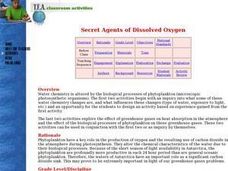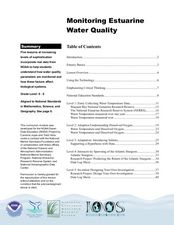Curated OER
Testing the Waters
Pupils use test kits to measure the level of chlorine, iron, sulfide, and dissolved oxygen in tap (drinking) water and stream water. They post and evaluate the results of these water quality tests.
Curated OER
Fish and Oxygen
Students explore what factors affect population dynamics, identify factors affecting fish populations, and use Stella to model how dissolved oxygen affects fish populations.
Curated OER
Salmon Scavenger Hunt
Learners go on a salmon scavenger hunt to find out about threats to salmon populations. They gather information about some of the reasons wild salmon have gone from such incredible abundance to relative scarcity, and about some of the...
Alabama Learning Exchange
Is My Water Safe?
Learners discuss what makes their drinking water safe and unsafe. They locate and visit a local tributary and test the water's pH, hardness, dissolved oxygen, and total alkalinity. They compose a summary paragraph about the tests and...
Curated OER
Science: Dissolved Oxygen and Water Quality Sampling
Learners perform tests to determine the level of oxygen dissolved in water. After examining a table displaying the temperature and solubility of water, they examine the three stages involved in the test. Upon completion, students explain...
Curated OER
Dissolved Oxygen Lesson
Students investigate what dissolved oxygen is and why it is important to aquatic life and what factors influence levels of dissolved oxygen in a lake. They study how to use MS Excel to make charts to show trends and correlations.
Curated OER
Secret Agents of Dissolved Oxygen
Students determine the changes in different types of water in a sealed container over time. They investigate how to measure dissolved oxygen, temperature, and carbon dioxide with calculator or computer probe-ware. Students determine the...
Curated OER
WATER QUALITY FOR FRESHWATER ORGANISMS
Students use determination of dissolved oxygen and water temperature changes to determine the environmental impact from thermal pollution.
Curated OER
Photosynthesis and Respiration
Students comprehend the relationship between plants and animals in an aquatic ecosystem. They predict the effects of low dissolved oxygen on the organisms. Students create microcosms with plants, animals, or both. They determine which...
Curated OER
Reading the River
In collaborative groups, young ecologists measure the temperature, pH, and dissolved oxygen for three different freshwater samples. They examine each sample with a microscope and record observations on the microorganisms in the pond...
Curated OER
Ecosystem Damage from Household Cleaners
Third graders assess the damage done to various ecosystems by cleaning products and discover how scientists test water quality. Using stream water and common household cleaning agents, they work in groups to test for pH levels. Once...
NOAA
The Dead Zone
The fifth installment of a 23-part NOAA Enrichment in Marine sciences and Oceanography (NEMO) program defines dead zones and how they form. Pupils then examine data from the Gulf of Mexico to determine dead zone formation.
Omaha Zoo
Monitoring Amphibians
What sort of shoes do frogs wear? Open toad sandals. If your scholars want experience collecting field samples, this is the lesson for you. After learning the proper way to collect field samples, pupils catch amphibians to test for...
Curated OER
When Things Heat Up
Ninth graders investigate relationship between the temperature and concentration of dissolved oxygen in water. They examine how pollution and other natural influences can cause the parameters to change. In groups, 9th graders collect...
Curated OER
Monitoring Estuarine Water Quality
Learners analyze water quality data from real data. In this environmental science lesson, students examine how salinity and dissolved oxygen affect the living organisms in the estuary. They interpret graphs to support or disprove a...
Curated OER
Great Lakes Ecology
Young scholars are able to use a secchi disk to measure the turbidity of water by determining the depth at which the sechi disk is no longer visible and using the data in a formula to quantify the results. They are able to use Vernier...
Curated OER
Freshwater Fish Water Quality
Sixth graders work together to complete an experiment about the quality of freshwater. In groups, they collect fresh water samples from a variety of sources and test the pH levels. After completing a KWL chart, they test the amout of...
Curated OER
What's in the Water?
Young scholars make a water sampler and use proper techniques to collect water.They write a essay explaining the inter-relationship of factors such as temperature, pH, dissolved oxygen, nitrates, and phosphates in a lake that might cause...
Curated OER
Cell Energy-Bubbling Plants
Students discuss the process of photosynthesis in plants and that oxygen is produced as a by product. They observe underwater Elodea plants "breathing" in a hands-on activity. After setting up the experiment, they observe the plant for...
NOAA
History's Thermometers
How is sea coral like a thermometer? Part three of a six-part series from NOAA describes how oceanographers can use coral growth to estimate water temperature over time. Life science pupils manipulate data to determine the age of corals...
Curated OER
Ocean Microstructure
Young scholars assess the ocean's microstructure by analyzing graphs created during tne Ronald H.Brown research cruise. they discuss at what depths various sea animals live and write paragraphs on data analysis from the graphs.
Science Matters
Under Pressure
Sometimes a little pressure isn't a bad thing! A collaborative lesson uses models to demonstrate how air pressure inflates and deflates the lungs. Participants use everyday materials to create models of the chest cavity to simulate how a...
Curated OER
Acid Rain Experiments
Students define the term acid rain, and the causes of acid rain. They locate regions where acid rain is most affected, and what can students deduce from maps of geology and soils in New York State. Students answer the questions why are...
Curated OER
Creek Monitoring
Sixth graders conduct a variety of assessments at a local stream to determine if it is a suitable habitat for salmon. They measure temperature, tubidity, dissolved oxygen, pH levels, bacteria and nutrients. For this unit, 6th graders...
Other popular searches
- Algae Dissolved Oxygen
- Ph and Dissolved Oxygen
- Dissolved Oxygen Fish
- Daphna Dissolved Oxygen
- Daphnia Dissolved Oxygen
- Dissolved Oxygen Levels
- And Dissolved Oxygen
- Coke Dissolved Oxygen
- Dissolved Oxygen Salmon
- Dissolved Oxygen Diurnal

























